By Nicki Richesin, The Children’s Book Review
Published: November 27, 2011
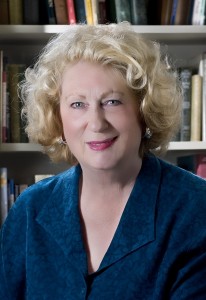
Angelica Shirley Carpenter is the author of many acclaimed biographies written for young people including Frances Hodgson Burnett: Beyond the Secret Garden, L. Frank Baum: Royal Historian of Oz, Robert Louis Stevenson: Finding Treasure Island, and Lewis Carroll: Through the Looking Glass. She also edited In the Garden: Essays in Honor of Frances Hodgson Burnett. Carpenter is the founding curator of the Arne Nixon Center for the Study of Children’s Literature at California State University in Fresno.
Nicki Richesin: Thank you for agreeing to do this interview. I know our readers will be fascinated by your writing life. You have established an impressive career as a biographer of many beloved and celebrated children’s book authors including Frances Hodgson Burnett, L. Frank Baum, Robert Louis Stevenson and Lewis Carroll. How did you first begin writing your books?
Angelica Shirley Carpenter: I began about 1988 when my mother Jean Shirley retired and moved from St. Louis to live near me in Palm Springs, Florida. Mother had already published several biographies for children and she arrived in Florida with a good idea for a new one, about Frances Hodgson Burnett. Oh, and she wanted us to write this together. In St. Louis Mother had found and read The One I Knew the Best of All, Frances’ autobiography of her childhood, and she thought that it would make a good starting point. I was running a small public library at this time, and I knew that children still read and loved The Secret Garden and A Little Princess, so I agreed that Frances would make a good subject. We established that the only biography of Frances Hodgson Burnett for young people had been written by her daughter-in-law in 1965. It lacked illustrations and, worse, it omitted certain incidents that were embarrassing to Frances’ family, like her divorce and remarriage. So we decided to write a more accurate account of her life and to try to publish it with photographs and illustrations from her books.
Your mother Jean Shirley was your co-author on three of your books. Could you tell us about her influence on your life and how you collaborated together?
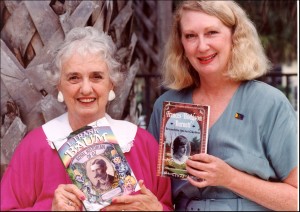
My mother was always a writer. When I was a child, her stories and poems were being published in magazines. She could type faster than 100 words a minute on her manual typewriter. She couldn’t cook very well (luckily, my father did), so our kitchen was always filled with the clatter of typewriter keys and stacks of papers. This all seemed normal to me. When Mother moved to Florida, she founded the first Florida chapter of what was then the Society of Children’s Book Writers. This effort helped her to make new friends of all ages. At first I resisted her efforts to get me involved, or to write with her, but finally she convinced me that Frances would be a fun project.
We collaborated easily because even though I was inexperienced, she let me take the lead. She knew how bossy I was, and I think that she was grooming me to be a writer on my own someday. When we worked together, we would agree on what should be covered in a chapter; then we each wrote our own version. Then we read them aloud and combined the two. Mother taught me all the writerly tips for writing biographies, or anything else, for that matter—observing the rule of three, ending chapters with cliffhangers, arranging quotations to look like dialogue, putting all five senses into every chapter, foreshadowing, replacing adjectives and adverbs with strong verbs—all those important ideas and more, plus she was a living grammar book. I never had to look up grammar or punctuation—I could just ask my mother. We had a wonderful time reading our work together and we discussed every single word. When the books were published, we had fun doing school visits together, too.
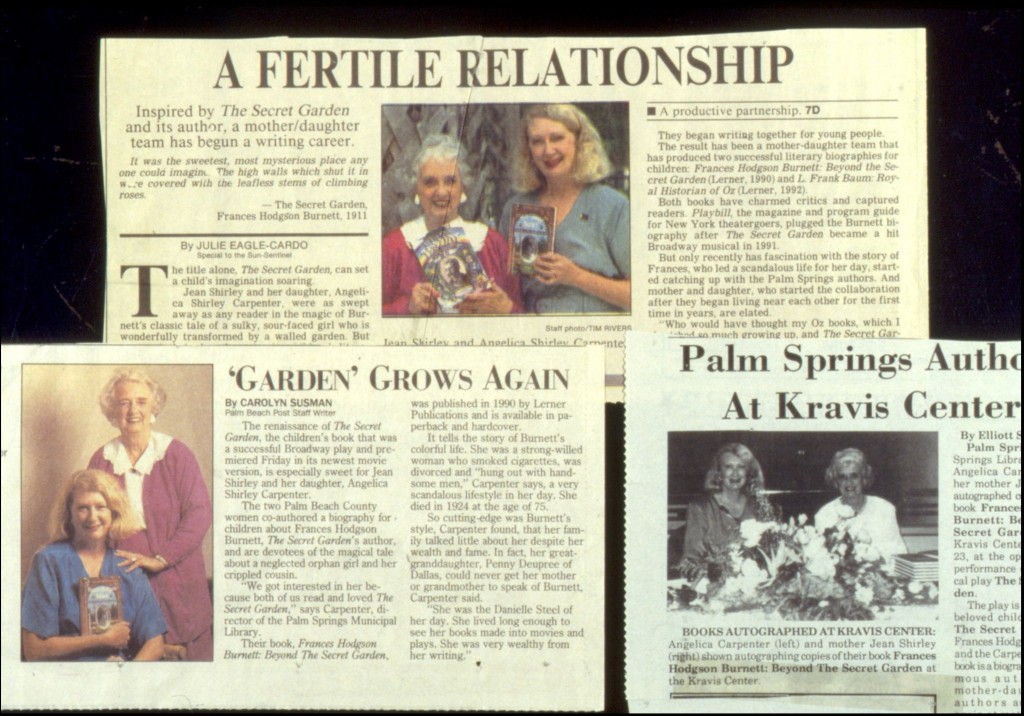
You have dedicated a great deal of your professional life to studying Frances Hodgson Burnett. I was surprised to learn, having grown up with great admiration for The Secret Garden and A Little Princess, that Burnett’s novel Little Lord Fauntleroy was her most successful book during her lifetime as Americans were quite taken with its rags to riches storyline. Did this come as a surprise to you when doing your research? Burnett led a somewhat unconventional life by Victorian standards. Were there certain periods of her life that you found remarkable?
It wasn’t just Americans who were fascinated with Fauntleroy—the British loved it, too, and it was read around the world, wherever English was spoken or studied. It was the Harry Potter of its day, made into a hit play and eventually a movie starring Mary Pickford. It was marketed with a lot of tied-in products. I read it for the first time as we worked on the biography, and quite enjoyed it. It was written at a time (in the mid-1880s) when society was changing drastically due to industrialization and new methods of travel. After a hundred years of independence, America had developed a national character that was distinct from Britain’s, and the British were curious about what their former subjects were up to. Frances, who crossed the Atlantic 33 times, wrote from both points of view, British and American, and helped to explain the two societies to each other.
She did live a fast-lane life for a respectable Victorian lady. Mother and I eventually met her great-granddaughter, Penny Deupree, who said that her mother and aunt (Frances’ granddaughters) would never even talk about Frances. They were scandalized by her divorce and remarriage. When I tell children this today, they are amazed. Many of the things that Frances did were unusual then—she dyed her hair, wore makeup, smoked cigarettes, and spent a lot of time unchaperoned with good-looking younger men. She married one of these, Stephen Townesend, her second husband, but when he turned out to be an abusive bully, she left him, too. None of this seems shocking today, but the fact that she left her young sons for long periods, up to a year at a time, does seem hard to understand.
I remember reading that Lewis Carroll was inspired by Julia Margaret Cameron’s portrait of Alice Liddell. Some of Carroll’s photographs were considered quite scandalous. Alice’s Adventures in Wonderland seems like a psychological study of how children act as adults by playing pretend yet are confused by the narrow rules adults enforce, just as Alice must determine how to navigate Wonderland. Could you briefly explain the role Alice Liddell played in Carroll’s writing and how his photography informed his work?
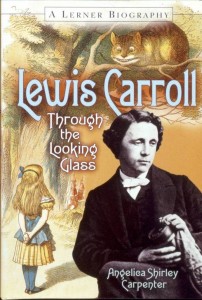 Alice Liddell was Lewis Carroll’s muse. He met her as he began his career as a mathematics tutor at Oxford University. She was the daughter of his college dean. Oxford in those days was all male, but Dean Henry Liddell was hired, unusually, as a married man with a family. Lewis Carroll, whose real name was Charles Lutwidge Dodgson, became a family friend. Soon after the dean was hired, Lewis Carroll bought a camera. He learned to use it by taking pictures of the Liddell children in the deanery garden. He told them stories, as he had done for his own ten brothers and sisters. The oldest Liddell child, Harry, was often away at boarding school. Lewis Carroll saw more of the three eldest sisters, Lorina, Alice, and Edith, who were educated at home. The stories Lewis Carroll told the girls were based on incidents from their lives at Oxford—croquet games, boating trips, and tea parties—familiar experiences reinvented with humor and a kind of incomprehensibility that children must experience all the time.
Alice Liddell was Lewis Carroll’s muse. He met her as he began his career as a mathematics tutor at Oxford University. She was the daughter of his college dean. Oxford in those days was all male, but Dean Henry Liddell was hired, unusually, as a married man with a family. Lewis Carroll, whose real name was Charles Lutwidge Dodgson, became a family friend. Soon after the dean was hired, Lewis Carroll bought a camera. He learned to use it by taking pictures of the Liddell children in the deanery garden. He told them stories, as he had done for his own ten brothers and sisters. The oldest Liddell child, Harry, was often away at boarding school. Lewis Carroll saw more of the three eldest sisters, Lorina, Alice, and Edith, who were educated at home. The stories Lewis Carroll told the girls were based on incidents from their lives at Oxford—croquet games, boating trips, and tea parties—familiar experiences reinvented with humor and a kind of incomprehensibility that children must experience all the time.
In his youth Lewis Carroll had longed to be an artist, but his talent for drawing was limited. Photography let him express himself visually, using principles he had studied as a would-be artist. Like other Victorian photographers, he sometimes photographed nude children; such photos were considered symbols of innocence in that male-dominated era. Unlike the other photographers, he became a best-selling children’s author and so his four surviving nude pictures are better known. His hundreds of photos of children are now considered the finest ever taken of children in Victorian times. He was a perfectionist in his photography and in his writing, too. Perhaps the earlier control over photography gave him the knowledge and the confidence he needed to exert the same kind of control over his writing and publishing.
You’ve made many literary pilgrimages over the years to Oxford, Kent, Newcastle upon Tyne, Sissinghurst Castle, among many other famous landmarks. Of all the trips you’ve made, which was your most rewarding and/or fascinating for you as a biographer?
It’s hard to say—each trip seems like the best until I start planning the next one. Certainly one of the most exciting days was on my first trip to England, in 1992, when I got to visit the walled garden at Great Maytham Hall in Kent. Frances Hodgson Burnett leased Maytham Hall from 1898-1907. Although she set The Secret Garden in Yorkshire, the garden she wrote about was that garden in Kent. I went there on a dazzling summer day with my husband and daughter, who was a college student at the time. They waited patiently while I ran around crying and taking pictures—I was overjoyed to be there. At the time, Great Maytham Hall had been made into apartments for retirees, who took turns showing guests around the garden. Our guide was Bill Brewin, who became a friend for the rest of his life. We returned several times, but that first viewing was the most exciting.
I had the pleasure of seeing you speak at the Mechanics Institute Library in San Francisco a few years ago. For many years, you have organized international conferences through the Arne Nixon Center where you work as the founding curator. Could you tell us about the annual events that you host and any upcoming events you’re planning?
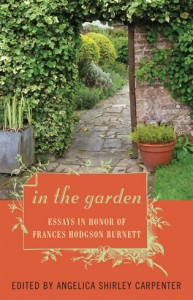 As founding curator of the Arne Nixon Center for the Study of Children’s Literature at California State University, Fresno, I have gotten to try a lot of new ideas. One goal was to put this new Center on the map by sponsoring conferences, which brought people here from around the world. The first one, in 2003, was a Burnett conference—amazingly, the first one ever held about this famous author. It resulted in a book, In the Garden: Essays in Honor of Frances Hodgson Burnett. In 2004 the Arne Nixon Center hosted the Children’s Literature Association’s annual conference. We have had good luck working with literary societies—the Lewis Carroll Society of North America, the British-based Beatrix Potter Society, the International Wizard of Oz Club, and the Friends of Freddy (the Pig). The Center’s annual event is a Secret Garden Party, hosted by our Friends’ group, ANCA, the Arne Nixon Center Advocates. ANCA held the first Secret Garden Party as a fundraiser for the Burnett conference. People in Fresno have lovely gardens, which they like to showcase. So ANCA planned a party, but kept the location secret until people bought tickets or sponsorships. The idea proved so popular that we kept having Secret Garden parties, changing themes, so that we had an Oz Secret Garden Party, an Alice party, a Cats party (to celebrate the acquisition of a collection of 6,000 cat books), and last year a Centennial Secret Garden Party, with a fashion show commemorating the University’s 100th birthday. You can see photos from all our events at www.arnenixoncenter.org. The 2012 Secret Garden Party will have a Cuban/Spanish flair because we will be honoring authors Alma Flor Ada and F. Isabel Campoy.
As founding curator of the Arne Nixon Center for the Study of Children’s Literature at California State University, Fresno, I have gotten to try a lot of new ideas. One goal was to put this new Center on the map by sponsoring conferences, which brought people here from around the world. The first one, in 2003, was a Burnett conference—amazingly, the first one ever held about this famous author. It resulted in a book, In the Garden: Essays in Honor of Frances Hodgson Burnett. In 2004 the Arne Nixon Center hosted the Children’s Literature Association’s annual conference. We have had good luck working with literary societies—the Lewis Carroll Society of North America, the British-based Beatrix Potter Society, the International Wizard of Oz Club, and the Friends of Freddy (the Pig). The Center’s annual event is a Secret Garden Party, hosted by our Friends’ group, ANCA, the Arne Nixon Center Advocates. ANCA held the first Secret Garden Party as a fundraiser for the Burnett conference. People in Fresno have lovely gardens, which they like to showcase. So ANCA planned a party, but kept the location secret until people bought tickets or sponsorships. The idea proved so popular that we kept having Secret Garden parties, changing themes, so that we had an Oz Secret Garden Party, an Alice party, a Cats party (to celebrate the acquisition of a collection of 6,000 cat books), and last year a Centennial Secret Garden Party, with a fashion show commemorating the University’s 100th birthday. You can see photos from all our events at www.arnenixoncenter.org. The 2012 Secret Garden Party will have a Cuban/Spanish flair because we will be honoring authors Alma Flor Ada and F. Isabel Campoy.
We just hosted a big conference in October, the ninth United States regional conference of IBBY, the International Board on Books for Young People. This was coordinated with a major exhibition, “Down the Rabbit Hole with Lewis Carroll and Leonard Weisgard.” So we are taking a bit of a breather, and doing some needed fundraising, before planning any more conferences.
Meanwhile we are working to promote our new collection of LGBTQ (Lesbian, Gay, Bisexual, Transgender, Queer/Questioning) books, which we think is the largest such collection of these books for young people in any library. My colleague, Jennifer Crow, is developing a traveling exhibition of these books that, with suitable funding, we hope to send out to California high schools.
You’re working on a new biography of Matilda Joslyn Gage for young readers. Why did you choose Gage as a subject and what has proved the most interesting about this project so far?
I found Matilda through her son-in-law, L. Frank Baum, author of the Oz books. Mother and I wrote our second biography about him, so Matilda has been on my radar since then. She was a famous feminist and author in her own right, but she is largely forgotten today, due to some skullduggery by Susan B. Anthony. Late in their lives, Anthony ousted Matilda from the organization they had co-founded and co-led for decades, along with Elizabeth Cady Stanton. Matilda Joslyn Gage and Elizabeth Cady Stanton were the main writers of the women’s movement. They co-authored the first three volumes of the History of Woman Suffrage, still the most important history of the women’s movement in the 1800s, and in 1893 Matilda published Woman, Church, and State, in which she attacked organized religion for oppressing women. So she is an interesting and controversial character, who, after she was widowed, spent winters with her daughter Maud and her son-in-law L. Frank Baum. It is fun to think of Matilda and Frank, writing very different kinds of material under the same roof, and I don’t think that it is a coincidence that, when you look at Frank’s 14-book Oz series, you see that Oz is a paradise ruled by women.
As a biographer, I’m sure you come across many enigmatic and captivating historical figures during your research. Is there one person you hope to write about that you haven’t yet had the opportunity to investigate?
The early feminists are interesting me now—I think that we need to know more about them, and not just about Susan B. Anthony and Elizabeth Cady Stanton. Recently the literature about civil rights history written for young people has expanded to include new subjects, people like Claudette Colvin and Bayard Rustin. I think that women’s history could use a similar expansion, but I don’t yet have any particular new subject in mind. I have to finish the Matilda book first. I’m calling it The Forgotten Feminist: Matilda Joslyn Gage.
Nicki Richesin is the editor of four anthologies,What I Would Tell Her: 28 Devoted Dads on Bringing Up, Holding On To, and Letting Go of Their Daughters; Because I Love Her: 34 Women Writers Reflect on the Mother-Daughter Bond; Crush: 26 Real-Life Tales of First Love; and The May Queen: Women on Life, Work, and Pulling it all Together in your Thirties. Her anthologies have been excerpted and praised in The New York Times, the San Francisco Chronicle, The Boston Globe, Redbook, Parenting, Cosmopolitan, Bust, Salon, Daily Candy, and Babble.
